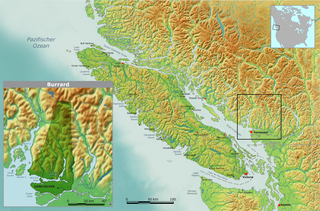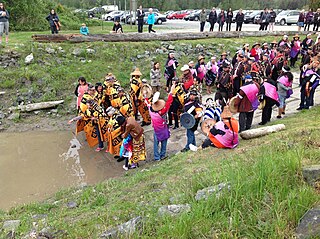
The Wahta Mohawks are a Mohawk First Nation in Ontario. The Wahta Mohawk Territory is their territory (reserve) in the District Municipality of Muskoka, Ontario, Canada near Bala. It is bounded on the west by Highway 400, a major north-south artery in the province. About one-third of the 831 citizens of Wahta Mohawk Territory live in the community of Wahta, along District Road 38, another third live within 100 km, and the remainder live elsewhere.

Burns Lake is a rural village in the North-Central Interior of British Columbia, Canada, incorporated in 1923. The village has a population of 1,779 according to the 2016 Census.
First Nations in Alberta are Indigenous peoples who live in the Canadian province of Alberta. The First Nations are peoples recognized as Aboriginal peoples in Canada excluding the Inuit and the Métis. According to the 2011 Census, a population of 116,670 Albertans self-identified as First Nations. Specifically there were 96,730 First Nations people with registered Indian Status and 19,945 First Nations people without registered Indian Status. Alberta has the third largest First Nations population among the provinces and territories. From this total population, 47.3% of the population lives on an Indian reserve and the other 52.7% live in urban centres. According to the 2011 Census, the First Nations population in Edmonton totalled at 31,780, which is the second highest for any city in Canada. The First Nations population in Calgary, in reference to the 2011 Census, totalled at 17,040. There are 48 First Nations or "bands" in Alberta, belonging to nine different ethnic groups or "tribes" based on their ancestral languages.

Wetʼsuwetʼen are a First Nations people who live on the Bulkley River and around Burns Lake, Broman Lake, and Francois Lake in the northwestern Central Interior of British Columbia. The name they call themselves, Wetʼsuwetʼen, means "People of the Wa Dzun Kwuh River or Bulkley River".

The Tsleil-Waututh Nation, formerly known as the Burrard Indian Band or Burrard Band, is a First Nations band government in the Canadian province of British Columbia. The Tsleil-Waututh are Coast Salish peoples who speak the Downriver dialect of the Halkomelem language, and are closely related to but politically and culturally separate from the nearby nations of the Squamish and xʷməθkʷəy̓əm (Musqueam), with whose traditional territories some claims overlap.
François Lake Provincial Park is a provincial park in British Columbia, Canada, located at the east end of Francois Lake. Total park area is 7,214 hectares. It is about 12 km off BC Highway 16, southwest of the town of Fraser Lake. There is no potable water at the site so campers should bring their own.

Kwantlen First Nation is a First Nations band government in British Columbia, Canada, located primarily on McMillan Island near Fort Langley. The Kwantlen people traditionally speak the Downriver dialect of Halkomelem, one of the Salishan family of languages.

M'Chigeeng First Nation, also known as West Bay, is an Ojibwe First Nation band government in the Manitoulin District of Ontario, Canada. The total registered population as of December 2018, was 2623 people, of which their on-reserve population was 939. The First Nation have reserved for themselves the 3094.7 ha M'Chigeeng 22 Indian Reserve located on Manitoulin Island.

The Pine Creek First Nation is a Saulteaux First Nation in Manitoba, Canada. The First Nation's homeland is Pine Creek 66A Reserve, located approximately 110 kilometres north of Dauphin along the southwestern shore of Lake Winnipegosis between the communities of Camperville and Duck Bay. The Rural Municipality of Mountain (South) borders it on the southwest.

Timiskaming is a First Nations reserve in the Abitibi-Témiscamingue region of Quebec, Canada, just north of the head of Lake Timiskaming. It belongs to the Timiskaming First Nation, an Algonquin band. It is geographically within the Témiscamingue Regional County Municipality but administratively not part of it.
The Nee-Tahi-Buhn Band is a First Nation located in the Interior of British Columbia near Burns Lake.
The Simpcw First Nation, formerly known as the North Thompson Indian Band, is a First Nations band government based in the Thompson Country of British Columbia, Canada. It is a member of the Shuswap Nation Tribal Council. It is a First Nations government of the Secwepemc (Shuswap) Nation, located in the Central Interior region of the Canadian province of British Columbia. The band's main community is at Chu Chua, British Columbia. Four of the five First Nation Reserves in Simpcw territory were designated on July 5, 1877 and the fifth was designated on February 24, 1916. The Shuswap language name for North Thompson Band's community and reserve is 'Simpcw'.

Big Horn 144A is a First Nations Indian reserve in Alberta, formed in 1948. The 5000-acre reserve is roughly 100 miles north of the settlement of Morley. It is composed of members of the Wesley band of Nakoda (Stoney) Indians.
Annapolis Valley First Nation is composed of two Mi'kmaq First Nation reserves located in southwestern Nova Scotia. As of 2017, the Mi'kmaq population is 119 on-Reserve, and approximately 173 off-Reserve for a total population of 292. The community has a gas bar, tobacco shop, gaming centre, health centre, and a chapel. It is the second smallest First Nation community in Nova Scotia in terms of population.
Pelican Lake First Nation is a member of the Federation of Saskatchewan First Nations, the body that represents 74 First Nations in Saskatchewan.

The Caldwell First Nation is a First Nations band government whose land base is located in Leamington, Ontario, Canada. They are an Anishinaabe group, part of the Three Fires Confederacy, comprising the bands Potawatomi, Odawa, and Ojibwa, whose members are originally of the Mikinaak (Turtle) and the Makwa (Bear) dodems. The Caldwell First Nation are a distinct and federally recognized Indian band and used to be referred to by such names as: the "Chippewas of Pelee", "Point Pelee Indians" and "Caldwell's band of Indians."
Indigenous or Aboriginal self-government refers to proposals to give governments representing the Indigenous peoples in Canada greater powers of government. These proposals range from giving Aboriginal governments powers similar to that of local governments in Canada to demands that Indigenous governments be recognized as sovereign, and capable of "nation-to-nation" negotiations as legal equals to the Crown, as well as many other variations.
The Mica Bay Incident was a land and resources dispute in along the shore of Lake Superior in November 1849. It is partially responsible for the signing of the 1850 Robinson-Huron Treaty.

The Unisʼtotʼen cabin and resistance camp is a reoccupation of the traditional, unceded territory of the Wetʼsuwetʼen First Nation. The camp was set-up in 2010 as a means to block access to Wetʼsuwetʼen territory by pipeline corporations and other resources extraction industries that do not have permission to access the land. Members of the Wetʼsuwetʼen First Nation feel they have a sacred duty to protect the land from harm and preserve it for future generations. The camp started in 2012. Located 1200 km by road from Vancouver, BC and about 130 km from the town of Smithers, it is on the shores of the Wedzin Kwah and mouth of the Gosnell Creek. These are all tributary to the Skeena, Bulkley, and Babine Rivers. Members of the Unisʼtotʼen clan, First Nations peoples, and other supporters staff the camp is staffed. Power is generated by a solar array. Water is supplied by the Morris River.











